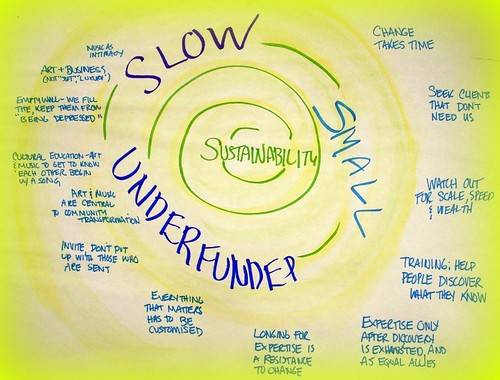
A couple of weeks ago, Peter Block said the qualities of successful community initiatives were, in his experience, being slow, small and underfunded. We all laughed, but looking around the room, his bravery in saying it seemed to resonate with many of us.
Have we been “communitied” to death? Has the abundance of choice, the speed with which commercial ventures have yet again jumped on to the “community” bandwagon anesthetized us to what “being together” as a community really is in our lives?
I was on a Skype call with a friend and colleague from Germany this morning and he was reflecting on how much he was enjoying working on an unfunded project. Used to the structure of organizations and businesses, he found the passion a wonderful, refreshing experience. I paused, then laughed and told him about hearing Peter Block. Something resonated. Bing!
Then, for fun, I said “what about a ‘slow community’ movement — like the ‘slow food’ movement?” We laughed, but again, that bell went off.
I thought I was joking, but now something is blossoming from that moment of humor. A few minutes later I read an email from Jay Cross recommending the article, Freedom to Learn :: Unitierra in Oaxaca by Gustavo Esteva. The article talks about the work of communities in Oaxaca who are eschewing schools and centrally designed learning experiences to take learning back into the hands of the community – on it’s own time, terms and tempo.
In the rush to colonize the possibility of community on the internet, with its characteristic speed and fleetness of metaphorical foot, we may have lost sight of the fact that some many of our most precious communities are slow, small and underfunded.
What kind of magic is this? What should we be paying attention to?
Is it time for a “slow community” movement? What would that look like to you? More importantly, how would it make your world a better place?
(Edit: Vanessa DeMauro had this thought in March. A good sign! )
 Blogs are often touted as “individual voices.” Of course, blogs can be many things, including reflective community voices. Check out the blog of the Tassajara Zen Center in California, facing many dangerous fires in their area on the Central California coast. Sitting with fire.
Blogs are often touted as “individual voices.” Of course, blogs can be many things, including reflective community voices. Check out the blog of the Tassajara Zen Center in California, facing many dangerous fires in their area on the Central California coast. Sitting with fire.